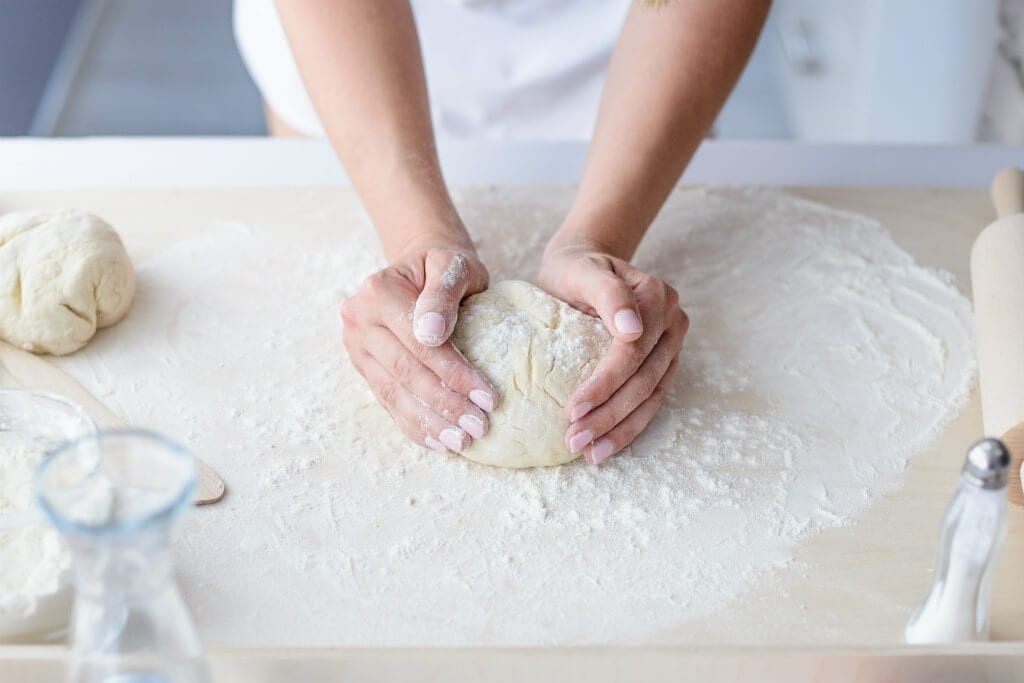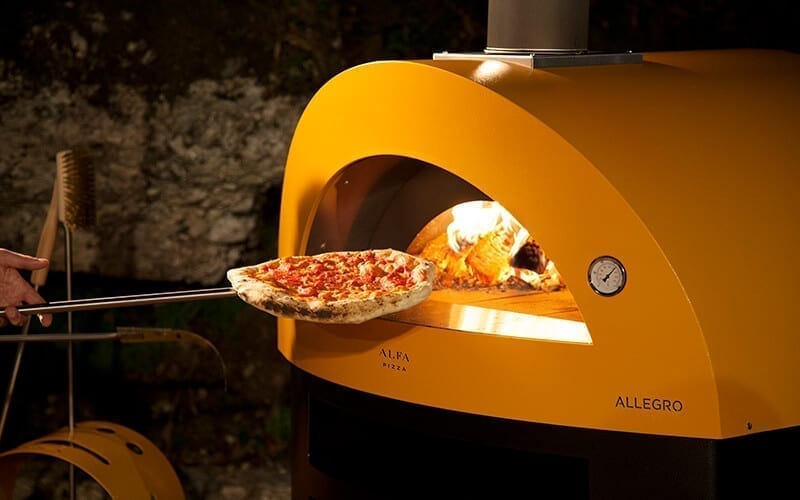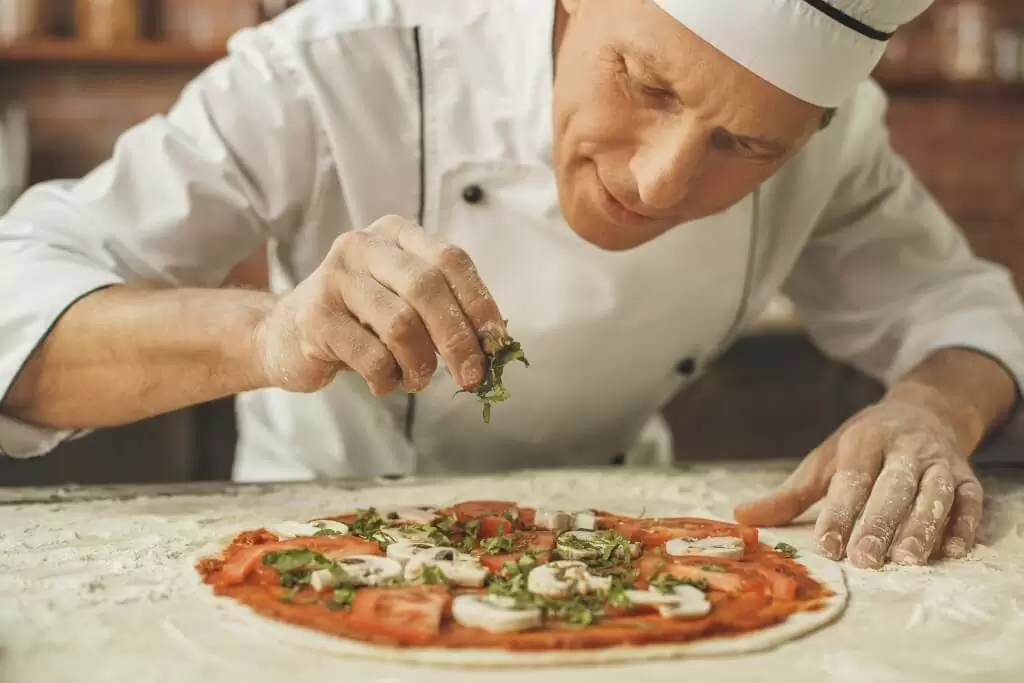Pizza is unquestionably one of the most famous and appreciated dish in the world but above all is, with pasta, the iconic Italian food. Each day, millions of pizzas are consumed all over Italy and the countless pizzerias dotting the “Bel paese” are quite a sight. Savouring a superb pizza in Capri or on the slopes of Vesuvius rather than in the narrow alleys of Rome or in some secret hamlet in Southern Italy is priceless. But when it comes to Italian pizza, the real challenge is only one: how to cook an authentic pizzeria-quality pizza at home.

Pizzeria-quality pizza: water, salt, yeast, flour and voilà les jeux sont faits but… at your place!
His recipe is very simple and includes a few choice genuine ingredients: soft wheat flour, fresh brewer’s yeast, water and salt. Pizza is one of the most ancient, tasty foods and among its many virtues are the fact that you can make it at home with great results. Knowing how to prepare a good pizza is something Italians are really proud of and more so for all the worldwide “white art” wizards. The pure pleasure of kneading pizza dough, watch it rise and in the end churn out a pizzeria-quality pizza is incomparable. To help the amateur pizza maker to make the homemade pizza par excellence here’s a guidebook to keep an eye on.
The main ingredient: the flour
Learning how to know, choose and use the right flour is absolutely key to make a good dough. Flour is in fact an umbrella term that encompasses a wide category of different products: some good, some bad and others that you should strictly avoid if you want to make a pizzeria-quality pizza at home. Flour contains all the basic nutrients of pizza such as proteins, carbohydrates (starch and sugars), vitamins, minerals and, to a lesser extent, lipids. Obviously, the concentration of these elements varies according to the type of flour. The mixing of water with flour and the subsequent mechanical action of hand or machine kneading involves a good number of changes that end up in what is known as dough. The most important process is the formation of gluten that provides the dough structure and traps gases coming from the fermentative action of yeast. The main problem for the amateur pizza maker is that normally the flours available on the market are too “soft” (low in gluten content) to make good pizzas. However, as luck would have it, Internet comes to our rescue and allows us to gain access to top-notch flour producers.
Brewer’s yeast or sourdough starter (natural yeast)?
The brewer’s yeast is very easy to use and it is strongly recommended for making pizza at home. Just be careful and follow some simple rules to make a great homemade pizza. If, on the contrary, you can’t give up sourdough starter we suggest that you use it with the brewer’s yeast and not in its place; this way, you may make the most of brewer’s yeast leavening power by exploiting the organoleptic properties of natural yeast.
Water, salt and….a good kneading is half the work.
After choosing flour and yeast, it’s time to focus on the two remaining ingredients: water and salt. Water is fundamental because it allows you to prepare pizza dough by mixing it with the flour. Pick a natural mineral water to make dough because the chlorine in tap water kills the yeast. Another major factor is the water temperature that is the only element that you can change to affect the dough. A rule of thumb is the so-called “rule 55” that is the sum of the room, flour (by convention it equals room temperature) and water temperatures in degrees Celsius. As for the salt, we remind you that it inhibits the yeast activity and then it should be added as late as possible (conversely yeast must be dissolved in water right away).

Maturation and leavening: how to make perfect pizza dough.
At this point, the dough is not yet ready to be used. Before that, you do need time. Time to allow the dough to rise and to mature. These two distinct processes do not take place at the same time and may depend, among other things, on the flour and on the dough temperature. With the right types of flour you can let the pizza dough rest for 48-72 hours; as for the temperature, the warmer the dough is during fermentation, the faster the yeast multiplies and produces carbon dioxide.
“Puntata”(bulk fermentation) and “appretto”(final proof): some pro techniques you can use at home as well.
The “puntata” is the phase where the dough is left in a compact mass before being cut into individual loaves (“staglio”). The timing of these two periods can be modulated according to various criteria or personal choices. The “staglio” is a pretty delicate process because by re-kneading the dough you re-strengthen gluten strands. The “appretto” stage allows the gluten to relax again, so the stronger the kneading the longer it should last.
Stretching, topping and cooking: the pizza is served….but in a pan!
A well-proofed pizza dough can be stretched so thin without tearing it. If the gluten is too developed, the dough doesn’t stretch so easily. If, on the contrary, the gluten is underdeveloped the dough tears. Once the dough is stretched out and topped with the good ingredients, it’s time for cooking. Cooking pizza is maybe the most difficult thing to do at home because it requires an oven that can reach very high temperatures. The best thing to do is going for a pan-baked pizza. Baking pizza in a pan needs temps closer to 300°C (570°F) with cooking times of about 8/10 minutes, so that’s the way to go. In this case, you can’t do without useful accessories such as blue or aluminized steel or lava stone pans taking care of heating them up before putting them in the oven.
Is the average electric oven really the weak point when cooking a homemade pizza?
At this point, pizza is ready for tasting. By following the aforementioned techniques you certainly realize how fun and easy is making pizza at home. Besides, by learning to make a home-made pizza in a professional way, you may objectively assess how good are other pizzas. However, one thing is clear: the common home oven doesn’t always fit the bill especially for cooking round pizzas.
But can you actually bake a pizzeria-quality pizza at home?
Probably you can’t make it, but you can get very close to it; bear in mind that the weakest link here is the oven. Getting a wood-fired or electric oven that can reach and keep the very high temps needed to cook pizza is the amateur pizza maker’s trump card. On the market there are ovens specifically designed to cook pizza doing the job. But if you don’t want to buy one of these appliances, you can find some viable alternatives. One of these is putting a refractory stone that holds very high temperatures on the bottom of the oven; this is a good solution to avoid heat loss when opening the oven door.
Se non si ha la possibilità di acquistare uno di questi forni, è opportuno ricordare che il problema maggiore della cottura della pizza nel forno di casa, si ha quando si inforna la pizza. All’apertura della porta del forno consegue la dispersione totale del calore accumulato. Come già annotato nelle fasi precedenti, per ovviare all’inconveniente della dispersione del calore, il consiglio è quello di di utilizzare una pietra refrattaria sul fondo del forno. In questo modo, il forno riuscirà a mantenere temperature elevate anche nel momento di apertura.


